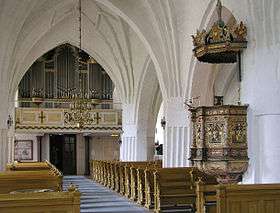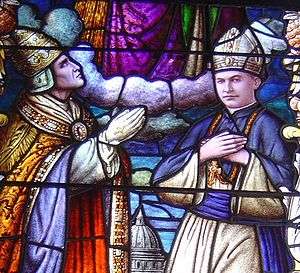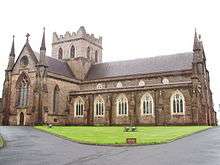Diocese


The word diocese is derived from the Greek term διοίκησις meaning "administration". When now used in an ecclesiastical sense, it refers to a territorial unit of administration.[1] In the Western Church, the district is under the supervision of a bishop (who may have assistant bishops to help him or her) and is divided into parishes under the care of priests; but in the Eastern Church, the word denotes the area under the jurisdiction of a patriarch and the bishops under his jurisdiction administer parishes.[1] This structure of church governance is known as episcopal polity.
The word diocesan means relating or pertaining to a diocese. It can also be used as a noun meaning the bishop who has the principal supervision of a diocese. A diocese also may be referred to as a bishopric or episcopal see, though strictly the term episcopal see refers to the domain of ecclesiastical authority officially held by the bishop, and the term bishopric to the post of being bishop.
An archdiocese (or archiepiscopal see or archbishopric) is more significant than a diocese. An archdiocese is presided over by an archbishop whose see may have or have had importance due to size or historical significance. The archbishop may have metropolitan authority over any other suffragan bishops and their dioceses within his ecclesiastical province.
In the Latter Day Saint movement, the term "bishopric" is used to describe the bishop himself, together with his two counselors, not the ward or congregation of which a bishop has charge.
Especially in the Middle Ages, some bishops (e.g. prince-bishops) held political as well as religious authority within their dioceses, which in practice were thus also independent or semi-independent states.
History

In the later organization of the Roman Empire, the increasingly subdivided provinces were administratively associated in a larger unit, the diocese (Latin dioecesis, from the Greek term διοίκησις, meaning "administration").
With the adoption of Christianity as the Empire's official religion in the 4th century, the clergy assumed official positions of authority alongside the civil governors. A formal church hierarchy was set up, parallel to the civil administration, whose areas of responsibility often coincided.
With the collapse of the Western Empire in the 5th century, the bishops in Western Europe assumed a large part of the role of the former Roman governors. A similar, though less pronounced, development occurred in the East, where the Roman administrative apparatus was largely retained by the Byzantine Empire. In modern times, many dioceses, though later subdivided, have preserved the boundaries of a long-vanished Roman administrative division. For Gaul, Bruce Eagles has observed that "it has long been an academic commonplace in France that the medieval dioceses, and their constituent pagi, were the direct territorial successors of the Roman civitates.[2]
Modern usage of 'diocese' tends to refer to the sphere of a bishop's jurisdiction. This became commonplace during the self-conscious "classicizing" structural evolution of the Carolingian Empire in the 9th century, but this usage had itself been evolving from the much earlier parochia ("parish"), dating from the increasingly formalised Christian authority structure in the 4th century.
Catholic Church
As of January 2015, in the Catholic Church there are 2,851 regular dioceses: 1 papal see, 641 archdioceses (including 9 patriarchates, 4 major archdioceses, 551 metropolitan archdioceses, 77 single archdioceses) and 2,209 dioceses in the world.[3]
In the Eastern rites in communion with the Pope, the equivalent unit is called an eparchy.
Eastern Orthodox Church
Eastern Orthodoxy calls dioceses metropoleis in the Greek tradition or eparchies in the Slavic tradition.
Church of England and Anglican Communion

After the Reformation, the Church of England retained the existing diocesan structure which remains throughout the Anglican Communion. The one change is that the areas administered under the Archbishop of Canterbury and Archbishop of York are properly referred to as provinces, not archdioceses. This usage is relatively common in the Anglican Communion.
Lutheranism
Germany and Nordic countries
Certain Lutheran denominations such as the Church of Sweden do have individual dioceses similar to Roman Catholics. These dioceses and archdioceses are under the government of a bishop (see Archbishop of Uppsala).[4] Other Lutheran bodies and synods that have dioceses and bishops include the Church of Denmark, the Evangelical Lutheran Church of Finland, the Evangelical Church in Germany (partially), and the Church of Norway.[5]
Lutheranism in the USA
Some American Lutheran church bodies such as the Evangelical Lutheran Church in America do have a bishop acting as the head of the synod,[6] but the synod does not have dioceses and archdioceses as the churches listed above. Rather, it is divided into a middle judicatory.[7]
The Lutheran Church-International, based in Springfield, Illinois, presently uses a traditional diocesan structure, with four dioceses in North America. Its current president is Archbishop Robert W. Hotes.[8]
Church of God in Christ
The Church of God in Christ (COGIC) has dioceses throughout the United States. In the COGIC, each state is divided up into at least three dioceses that are all led by a bishop, but some states as many as seven dioceses. These dioceses are called "Jurisdictions."
Churches that have bishops, but not dioceses
Methodism
In the United Methodist Church (the United States and some other countries), a bishop is given oversight over a geographical area called an Episcopal Area. Each episcopal area contains one or more annual conferences, which is how the churches and clergy under the bishop's supervision are organized. Thus, the use of the term "diocese" referring to geography is the most equivalent in the United Methodist Church, whereas each annual conference is part of one episcopal area (though that area may contain more than one conference). The African Methodist Episcopal Church has a similar structure to the United Methodist Church, also using the Episcopal Area. Note that the bishops govern the church as a single bench.
In the British Methodist Church and Irish Methodist Church, the closest equivalent to a diocese is the 'circuit'. Each local church belongs to a circuit, and the circuit is overseen by a superintendent minister who has pastoral charge of all the circuit churches (though in practice he or she delegates such charge to other presbyters who each care for a section of the circuit and chair the local church meetings as deputies of the superintendent). This echoes the practice of the early church where the bishop was supported by a bench of presbyters. Circuits are grouped together to form Districts. All of these, combined with the local membership of the Church, are referred to as the "Connexion". This 18th-century term, endorsed by John Wesley, describes how people serving in different geographical centres are 'connected' to each other. Personal oversight of the Methodist Church is exercised by the President of the Conference, a presbyter elected to serve for a year by the Methodist Conference; such oversight is shared with the Vice-President, who is always a deacon or layperson. Each District is headed by a 'Chair', a presbyter who oversees the district. Although the district is similar in size to a diocese, and Chairs meet regularly with their partner bishops, the Methodist superintendent is closer to the bishop in function than is the Chair. The purpose of the district is to resource the circuits; it has no function otherwise.
The Church of Jesus Christ of Latter-day Saints
The Church of Jesus Christ of Latter-day Saints (LDS Church) has bishops, but not dioceses. LDS bishops are leaders of a ward. They serve a term, or calling, and are sustained by the members of the ward. The bishop and two councilors are called the bishopric. A ward is similar in size to a parish or congregation. Branches, which are smaller than a ward are led by a branch president.
Churches that have neither bishops nor dioceses
Baptists
Most Baptists hold that no church or ecclesiastical organization has inherent authority over a Baptist church. Churches can properly relate to each other under this polity only through voluntary cooperation, never by any sort of coercion. Furthermore, this Baptist polity calls for freedom from governmental control.[9] Most Baptists believe in "Two offices of the church"—pastor-elder and deacon—based on certain scriptures (1 Timothy 3:1–13; Titus 1–2).
Exceptions to this local form of local governance include a few churches that submit to the leadership of a body of elders, as well as the Episcopal Baptists that have an Episcopal system.
Churches of Christ
Churches of Christ, being strictly non-denominational, are governed solely at the congregational level.
See also
- Church of England § Structure
- Global organization of the Catholic Church
- Lists of patriarchs, archbishops, and bishops
- Notitia Dignitatum
- Particular church
Notes
- 1 2 Cross, F.L. & Livingstone, E.A. "Diocese" in The Oxford Dictionary of the Christian Church OUP (1974)
- ↑ Eagles, Bruce (2004). "Britons and Saxons on the Eastern Boundary of the Civitas Durotrigum". Britannia. 35. p. 234., noting for instance Wightman, E.M. (1985). Gallia Belgica. London. p. 26.
- ↑ See List of Roman Catholic dioceses (structured view).
- ↑ Adam of Bremen, Gesta Hammaburgensis ecclesiae pontificum, online text in Latin; scholia 94.
- ↑ see List of Lutheran dioceses and archdioceses.
- ↑ Office of the Presiding Bishop on ELCA.org. Retrieved 2010-16-04.
- ↑ LERNing newsletter from July 2005 at ELCA.org. Retrieved 2010-16-04.
- ↑ "Lutheran Church-International".
- ↑ Pinson, William M., Jr. "Trends in Baptist Polity". Baptist History and Heritage Society.
Sources and external links
| Look up Diocese or Bishopric in Wiktionary, the free dictionary. |
| Wikimedia Commons has media related to Monk. |
| Wikidata has the property: diocese (P708) (see uses) |
- Definition from 1911 Britannica at the Wayback Machine (archived April 5, 2006)
- Complete list of Catholic dioceses worldwide by GCatholic.org
- Virtually complete list of current and historical Catholic dioceses worldwide
- Another such list, in English and Norwegian
- List of current Anglican/Episcopalian dioceses
-
 Herbermann, Charles, ed. (1913). "Diocese". Catholic Encyclopedia. New York: Robert Appleton Company.
Herbermann, Charles, ed. (1913). "Diocese". Catholic Encyclopedia. New York: Robert Appleton Company. - Indian Orthodox Church Diocese Portal
- Coats of Bishops and of Dioceses
- Ligação externa Diocese de Santo Anselmo - Brasil